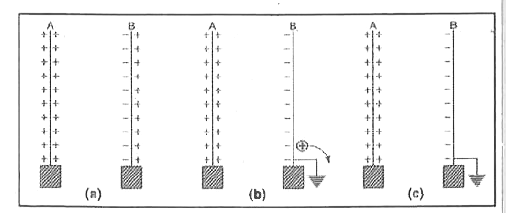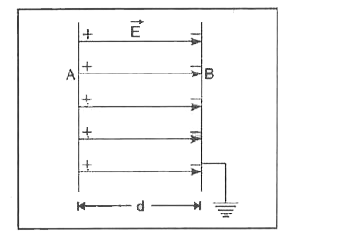Derive an expression for the capacitance of a parallel plate capacitor. Explain the effect of dielectrics on capacitance of this capacitor.
Or.
Derive expression for capacitance of a parallel plate capacitor. Explain the effect of dielectrics on its capacitance.
Capacitor is an arrangement for storing a large amount of electric charge hence electric energy in a very small space.
Principle. It is based on the principle that when an earthed conductor is placed in the neighbourhood of a charged conductor, the capacitance of the system increases considerably.
Let positive charge be given to a plate A till it is maximum positive [Fig (a)]. Now consider another insulated plate B held near A. By induction, nearer side of B acquired negative and farther side positive potential. whereas the induced negative charge tries to decrease the potential of A, induced positive charge tries to increase the potential of A. since induced negative charge in nearer, its effect is larger than induced positive charge. hence the potential of A gets reduced and capacity is increased.

Connect B to the earth [Fig. (b)]. induced free positive charge goes to the earth wheares induced negative charge remains bound. due to this, potential of A is greatly reduced and its capacity increased enormously.
Thus, capacitance of an insulated conductor is increased considerably by bringing near it an uncharged earthed conductor. this is the principle of capacitor.
Expression for capacitance of parallel plate capacitor
parallel plate capacitor consists of two thin conducting plates A and B held parallel to each other at a certain distance d apart. medium between plates is given to the vacuum. plate A is insulated and B is earthed.
When charge +q is given to A, it induced -q on the nearer face of B and +q on the farther face of the plate B.
free ve charge on B flows to the earth.
Electric field intensity between the plates is
Where is the charge density and equal to .

now, , where V is the P.D. between plates.
If the medium between the plates has dielectric constant K, then the capacitance of the capacitor become .
Topper's Solved these Questions
- ELECTROSTATICSBOOK - MBD -HARYANA BOARDCHAPTER - ELECTROSTATICSEXERCISE - OBJECTIVE TYPE QUESTIONS
23 Videos
- ELECTROSTATICSBOOK - MBD -HARYANA BOARDCHAPTER - ELECTROSTATICSEXERCISE - SHORT ANSWER TYPE QUESTIONS
11 Videos
- Electromagnetic WavesBOOK - MBD -HARYANA BOARDCHAPTER - Electromagnetic WavesEXERCISE - Example
7 Videos
- MAGNETISMBOOK - MBD -HARYANA BOARDCHAPTER - MAGNETISMEXERCISE - OBJECTIVE TYPE QUESTIONS
17 Videos
Similar Questions
Knowledge Check
A parallel plate capacitor is filled with dielectrics. What is capacitance?
 A2K1K2K1+K2BK1K2K1+K2C2ε0Ad(K1K2K1+K2)D2ε0Ad(2K1+K22K1K2)
A2K1K2K1+K2BK1K2K1+K2C2ε0Ad(K1K2K1+K2)D2ε0Ad(2K1+K22K1K2)In a parallel plate capacitor, the capacitance
Aincreases with increase in the distance between the platesBdecreases if a dielectric material is put between the platesCincreases with decrease in the distance between the platesDincreases with decrease in the area of the plates
Define capacitance of a parallel plate capacitor,Derive an expression for the capacitance of a parallel plate capacitor with dielectric of thickness "t," where "(t
View SolutionWhat is the effect of presence of a dielectric medium on
(i) capacitance of a parallel plate capacitor
(ii) electrostatic force between two charges ?
View SolutionDerive expresion for capacitance of a parallel plate capacitor and explain the combination of capacitors in series.
Or.
Write expression for three capacitors in series and parallel combinations.
View SolutionBriefly explain the principle of a capacitor. Derive an expression for the capacitance of a parallel plate capacitor, whose plates are separated by a dielectric medium.
View SolutionBriefly explain the principle of a capacitor. Derive an expression for the capacitance of a parallel plate capacitor, whose plates are separated by a dielectric medium.
View SolutionExplain why the capacitance of a parallel plate capacitor increases when a dielectric slab is introduced between the plates.
View Solution
